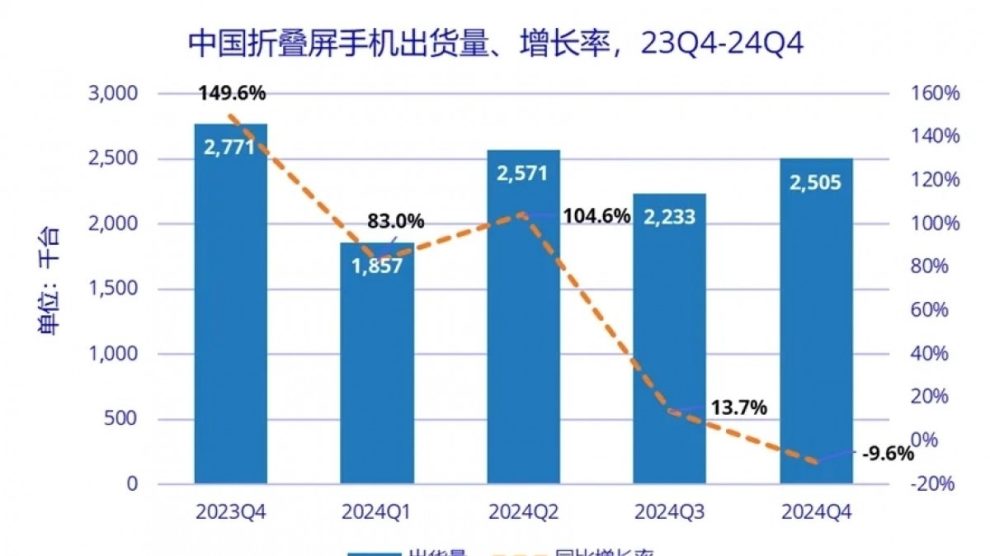Huawei Technologies, a name synonymous with technological innovation, has once again underscored its prowess in the foldable smartphone market in China. According to a recent report from the International Data Corporation (IDC), Huawei has not only solidified its leadership position but has also significantly outpaced its competitors in this rapidly evolving segment. This development is a testament to the company’s strategic focus on innovation, quality, and market adaptation.

China’s smartphone market is one of the most competitive globally, with numerous players vying for consumer attention. Within this challenging landscape, foldable smartphones represent a niche yet rapidly growing segment. Huawei’s dominance in this space is not just about market share but reflects a deeper understanding of consumer needs and technological trends.
The IDC report reveals that Huawei’s market share in China’s foldable segment has reached a staggering 50%. This means that every second foldable smartphone sold in the country is a Huawei device. Such dominance is rare in a market characterized by intense competition and rapid innovation cycles. This achievement also highlights Huawei’s resilience, particularly given the external pressures the company has faced in recent years, including sanctions and supply chain challenges.
Huawei’s foldable smartphones, including the Mate X series and the P50 Pocket, have been praised for their cutting-edge technology, durability, and user-centric design. The company’s commitment to research and development has enabled it to stay ahead of the curve, offering products that combine functionality with innovation. For instance, the Mate X3, one of Huawei’s flagship foldable devices, features a lightweight design, robust hinge mechanism, and superior camera technology, setting it apart from competitors.
The success of Huawei’s foldables can also be attributed to its ecosystem approach. Unlike traditional smartphones, foldables require a seamless integration of hardware and software to deliver a compelling user experience. Huawei has excelled in this regard, leveraging its HarmonyOS operating system to optimize the performance of its foldable devices. HarmonyOS ensures smooth multitasking, enhanced battery life, and a user-friendly interface, making Huawei’s foldables an attractive choice for both tech enthusiasts and everyday users.
Another factor contributing to Huawei’s success is its ability to address the premium segment of the market. Foldable smartphones are inherently positioned as high-end devices due to their advanced technology and higher production costs. Huawei has effectively targeted this segment by offering products that justify their premium price through superior features and performance. This strategy has resonated well with Chinese consumers, who are increasingly willing to invest in devices that offer value beyond conventional smartphones.
Price, however, is not the only consideration for consumers. The durability and practicality of foldable smartphones have often been questioned. Huawei has tackled these concerns head-on by investing in robust hinge designs, foldable displays, and durable materials. The Mate X3, for example, has been lauded for its water resistance and lightweight build, addressing key pain points for users of earlier foldable models.
Competition in the foldable segment is fierce, with players like Samsung, Oppo, and Vivo also vying for market share. Samsung, a global leader in foldable technology, has struggled to replicate its international success in China. IDC’s report highlights that while Samsung’s Galaxy Z Fold and Flip series are popular globally, their market share in China remains limited. Oppo and Vivo, on the other hand, have made significant inroads into the foldable segment, but their offerings have yet to match the comprehensive appeal of Huawei’s products.
A table comparing key features of Huawei’s Mate X3 with competitors like Samsung’s Galaxy Z Fold 5 and Oppo’s Find N3 provides a clearer picture of why Huawei leads the pack.
| Feature | Huawei Mate X3 | Samsung Galaxy Z Fold 5 | Oppo Find N3 |
|---|---|---|---|
| Display Quality | Ultra HD Foldable OLED | Dynamic AMOLED 2X | LTPO AMOLED |
| Hinge Durability | Advanced Water Resistant | Non-Water Resistant | Standard Durability |
| Weight | 239 grams | 253 grams | 260 grams |
| Battery Life | Superior Optimization | Average Performance | Above Average |
| Price Range | Premium | Premium | Slightly Lower |
This table underscores Huawei’s competitive edge in areas like display quality, hinge durability, and battery performance, which are critical for foldable devices.
The Chinese market’s preference for Huawei foldables also stems from the company’s strong brand reputation and patriotic sentiment among consumers. Huawei is often seen as a symbol of Chinese innovation and resilience, especially in light of challenges posed by international sanctions. This sentiment has translated into consumer loyalty, further bolstering Huawei’s position in the market.
Looking ahead, Huawei’s dominance in the foldable segment is likely to influence the broader smartphone industry. As foldables become more mainstream, competitors will need to innovate aggressively to close the gap. For you as a consumer, this means more choices and better technology in the years to come. However, Huawei’s early lead gives it a significant advantage in shaping the future of foldable smartphones.
The IDC report also sheds light on the broader implications of Huawei’s success. It highlights the importance of innovation in maintaining a competitive edge in the technology sector. Huawei’s ability to lead in a challenging segment like foldables demonstrates that even in the face of adversity, a focus on quality and consumer needs can yield remarkable results.
In conclusion, Huawei’s dominance in China’s foldable smartphone market is not just a testament to its technological capabilities but also a reflection of its strategic vision. By prioritizing innovation, durability, and user experience, Huawei has set a high benchmark for the industry. For you, this means access to cutting-edge technology that redefines what a smartphone can do. As the foldable segment continues to evolve, Huawei’s leadership is likely to inspire further advancements, making the future of smartphones even more exciting.










Add Comment